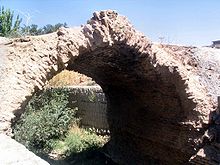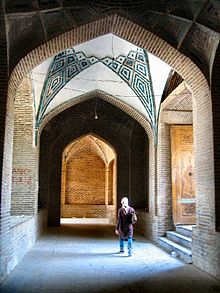Borudscherd
| Borudscherd | ||
|---|---|---|
|
|
||
| Basic data | ||
| Country: |
|
|
| Province : | Lorestan | |
| Coordinates : | 33 ° 54 ' N , 48 ° 45' E | |
| Height : | 1670 m | |
| Surface: | 35 km² | |
| Residents : | 231,000 (2008) | |
| Population density: | 7 inhabitants per km² | |
| Time zone : | UTC +3: 30 | |
Borudscherd ( Persian بروجرد, DMG Borūǧerd ) is a city in Lorestan Province in western Iran . It is also the center of the district of the same name.
Borujerd is one of the oldest cities of Iran, the region at the time of the Sassanids in Nahavand marginalized. During the Seljuk rule (9th – 10th centuries), the city gained in importance and became a geostrategically important trading center of the Zagros region , which it remained until the 20th century. During its heyday in the Qajar period (18th and 19th centuries), Borudscherd became the center of Lorestan and Khuzestan . Today Borudscherd is the second largest city in the Lorestan province and at the same time the regional center for industry, culture and tourism. The cityscape is characterized by numerous mosques , bazaars , bridges and houses that were built during the Seljuk and Qajar reigns.
The urban population of Borudscherd is generally considered to be tolerant, and so several religious minorities have settled there over time, including followers of the Jewish faith, Sufism and the Baha'i religion. The city also bears the name Daro-s-Sorur, which means something like place of happiness . Today Borudscherd is sometimes referred to as Little Paris (Paris-e Kutschulu) .
Geography and climate
Borudscherd is about 1670 m above sea level. The climate is determined by mild temperatures in summer and cold winters. The highest point is the Garrin Mountain, 3623 m high, and the lowest is the Gelerud River in the south, at an altitude of 1400 m. The administrative area of Borudscherd extends over an area of 2600 km² with 400,000 inhabitants and includes 180 other villages in addition to the city.
Borudscherd lies in the Silakhor plain, the largest agricultural area of Lorestan, which is surrounded from the southeast to the southwest by the mostly snow-covered Zagros Mountains. The rural population works on farms or has their own cattle. The urban population works in factories, small businesses, government offices or in the army. During the summer months, many nomads, such as Luren and Bakhtiari , gather at the foot of the Zagros Mountains to graze their cattle.
Several highways run through the area. It forms a cross between Khusestan and Tehran , as well as between Esfahan and Kermanshah .
history
The area around Borudscherd became at least the 3rd century BC. Inhabited. Medes used the pastureland for horse breeding and horse training . The Seleucids established a strategic military garrison in Rumian Castle . Under the Sassanids , Borudscherd developed into a city in which they built a fire temple .
In the fight against the Arab conquerors (637–651), the Iranians used the Borudscherd castle to support the troops. The last battle took place at Nahavand , 55 km northwest of Borudscherd. After the defeat, Yazdgerd III sought . took refuge in Borudscherd Castle, where his army followed him. The Islamic governor of the Arabs Abudol ibn Hamulah had the city rebuilt and put the Jame 'Mosque on top of the Zoroastrian fire temple.
Seljuk rulers often traveled to Borujerd and many of their battles took place here. Berk-Yaruq , Sultan of the Great Seljuks (1094–1105), died in Borudscherd. According to some sources, Zavvarian, 5 km north of the city, is his tomb, but most historians agree that his body was brought to Isfahan .
From around 1000 to 1500 Borudscherd was ruled by the Atabegs of Kleinluristan ( Lur-i kutschik ). Genghis Khan and the Mongols attacked their principality and destroyed both Borudscherd and Khorramabad . Also Timur attacked the city and destroyed it twice, but took advantage of Timurid the Borudscherd- and Rumian lock for their military purposes.
During the Safavid rule (1500–1700) Borudscherd was ruled as an independent area that included Japlaq or Gapleh and was adjacent to Golpayegan.
The Zand Kings (1750–1794) came from Loristan and came from the area around Borudscherd and Malayer .
During the Qajar period (1779-1925) the city grew rapidly and developed into the center of several administrative areas (Borudscherd, Lorestan and Khuzestan). Many buildings, including the Soltani Mosque, the Grand Bazaar, several schools and gardens were built and the city palace was rebuilt.
After Reza Shah Pahlavi (1925–1944) came to power, he had some uprisings put down in Lorestan. He rebuilt the army and had railways, roads, hospitals and modern schools built in Borudscherd. During this time the former Borudscherd region was dissolved and the city was assigned to the Lorestan province.
After the revolution of 1979 and during the Iran-Iraq war , Borudscherd took in many injured and refugees from the province of Khuzestan , although it was itself attacked several times. In one attack alone, 65 children died in a primary school. In recent years the population has increased again, but the city has suffered from social problems such as unemployment and drug abuse .
In March 2006, 66 people died and 1,400 were injured in the Borudscherdi earthquake .
Historical sights
- Borudscherd Friday Mosque
- Soltani mosque
- Imamzade Ja'far
- Imamzade Ghasem
- Imamzade Ibrahim
- Imamzade Schahzade Abol-Hasan
- Imamzade Vallian
- Imamzade Ghasem
- Zavvarian tomb in Borudscherd
- Ghale Hatam Bridge
- Chalantschulan Bridge, Borudscherd
- Ghorogh Bridge
- Rumian Bridge
- Borudscherd bazaar
Many of the archaeological sites have not yet been explored.
language
Borudscherd speaks a dialect typical of the city , a mixture of Lori and the standard Persian language . Occasionally one can also find other dialects such as Lori , Leki , local Azeri , and Judaeo-Persian, the local Jewish language .
Parks and natural attractions
- The Goldasht Valley
- The Vennaii village
- The Chogha Mountain
- Bische Dalan pond
- Oschtorankuh, Dorood
- The women's park in Borudscherd
sons and daughters of the town
- Hossein Borudscherdi (1875–1961), Grand Ayatollah
- Abdolhossein Zarinkoob, literary scholar and historian
- Loris Tscheknavorian, composer (* 1937)
- Ja'far Shahidi, historian
- Abdolmohammad Ayati, writer and poet
- Mehrdad Avesta, contemporary poet
- Allameh Bahr-ol-Olum, religious scholar of the 19th century
- Samet Borudscherdi, poet (19th and 20th centuries)
- Ehsan Mohadscher Schodschaei, athlete
Other spellings
Borujerd, Boroujerd, Borudjerd, Boroojerd, Brujerd, Burujird, Borugerd
gallery
See also
Web links
- Entry in the Encyclopedia of the Orient (English)
- Entry in the Encyclopaedia Britannica
- 1909 Silakhor earthquake (English) and 2006 Borudscherdi earthquake (English)







